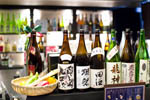Fish Net
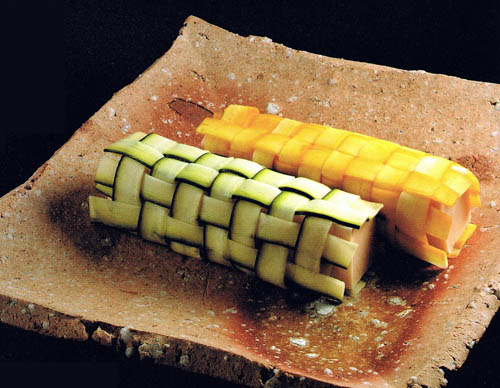
Salmon Mousse and Sole Wrapped in Zucchini
The Fish Net allows you to capture and roll up a delicate, tender portion of food with a layer of vegetable for a decorative effect that is reminiscent of nori-wrapped sushi rolls. True to the fish theme, the two rolls here are stuffed with Salmon Mousse and a soft, grilled sole.
Rolls can be stuffed with other foods of course, or the Fish Net can be laid flat with food set on top of it. For neat rolling, use a bamboo sushi mat or a damp cloth that will not stick.

1. Trim and discard the rounded side of the zucchini, then cut the zucchini into strips. |

2. Parboil strips in salted water (1 tbsp to 1 cup/ 240ml water) for 10 to 15 seconds, cool, and weave together. |
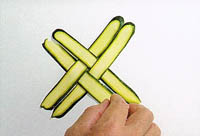
3. The garnish-in-progress should look like this after the fourth strip. |

4. Continue to weave. |

5. Trim ends and adjust. |
Sole is used here, but any tender whitefish, lightly grilled or steamed, can be served. Lightly sauteed, the tender flesh of the sole melds perfectly with parboiled zucchini. Both are soft and succulent. The Salmon Mousse, delicate and airy, also complements its zucchini covering to perfection.
Give new life to some of your own standard dishes by wrapping them in Zucchini Fish Nets, then stand aside and watch the delight of family and friends when they see your makeover.
Zucchini Rolls
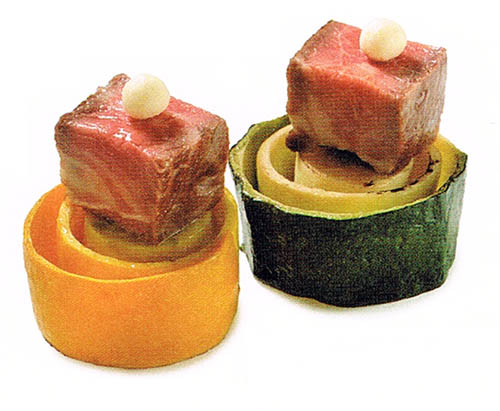
Prime Rib Cubes over Sauteed Zucchini
Here the zucchini rolls provide an edible decorative base for tasty morsels of beef, but of course the idea lends itself to numerous possibilities. An ongoing theme in these pages is to combine a succulent morsel of food with something simple yet substantial such as zucchini. Use your imagination to provide additional toppings, or to supplant the zucchini with a new vegetable.
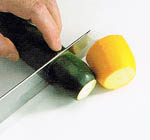
1. Trim ends of the zucchini then cut into 1-inch-thick (2.5cm) discs. |
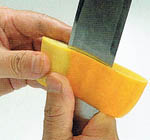
2. Cut to make swirling pattern. |
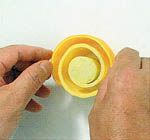
3. Saute or serve raw. |
The prime rib is topped with a ball of horseradish and should be served with steak sauce or a dressing of your choice. Season with salt and pepper to taste. In the meat department, cubes of chateaubriand or another piece of tenderloin will work equally well.
For seafood, consider sauteed scallops or fried oysters. When dealing with seafood, for best results choose fresh specimens in season.
Zucchini Boat with Paddle
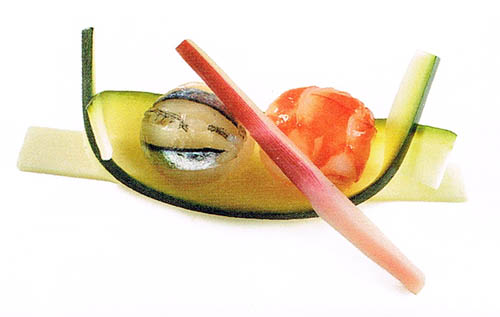
Sushi Balls with Sprig of Ginger
The Zucchini Boat is another example of a food garnish that is made with little effort but delights with its seeming complexity. Add colorful "passengers," as is done here, and the Boat comes to life. The fun - and cook's challenge - is in finding an appropriate paddle for the food of his or her choice.
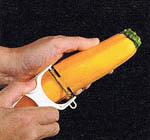
1. Peel the zucchini. |
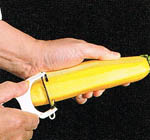
2. Cut it into long strips. |
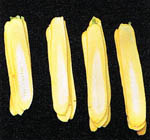
3. Stack and... |
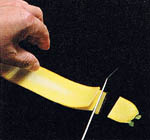
4. ...trim the top and bottom. |
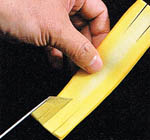
5. Cut the top and bottom into thirds as shown. |
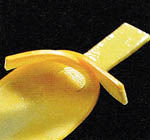
6. Cross two outside strips. Repeat on the other side. |
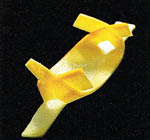
7. The finished Boat. |
Follow any sushi recipe and season rice for sushi, then roll rice into small, bite-size balls. Cut fish so it drapes nicely over the rice, place on top and shape gently to finish. Here shrimp and sayori (needlefish or halfbeak) are used, but any flexible sushi topping will work. Or try other round food - shrimp balls, meatballs, or any appetizer that lends itself easily to a circular shape.
Source Notes
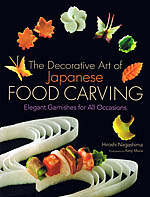
Reprinted with permission from the book:
The Decorative Art of Japanese Food Carving: Elegant Garnishes for All Occasions
Kodansha International
Japanese cuisine is renowned for the beauty of its presentation. Among the key elements in this presentation style are mukimono -- the decorative garnishes and carvings that add the final flourish to a dish.
In The Decorative Art of Japanese Food Carving, internationally acclaimed chef Hiroshi Nagashima offers 60 edible garnishes and food carvings for home, party or professional use. Some are designed to be set on top of the food. Others are fashioned to hold the food -- and sometimes, they simply are the food.
Each is introduced in full color, with easy-to-follow, step-by-step instructions, sample food arrangements, further ideas and secret, insider tips for successful presentation. Most are simple enough for the amateur chef to master, although a few are quite challenging and require much practice.
The Decorative Art of Japanese Food Carving is more than a practical handbook, however. It is also an inspiration book, filled with creative suggestions and inventive ideas to enhance and transform the way we cook.
ISBN4-7700-3087-8
- Order this book from amazon.com
- Order this book from amazon.co.jp (in Japan)
- Find this book at your local English-language bookstore in Japan
- Or use the ISBN to order from your local bookstore.
More articles
- © Copyright Lobster Enterprises
- Privacy
- Bento.com top
- © Copyright Lobster Enterprises
- Privacy
- Bento.com top
- © Copyright Lobster Enterprises
- Privacy
- Bento.com top








